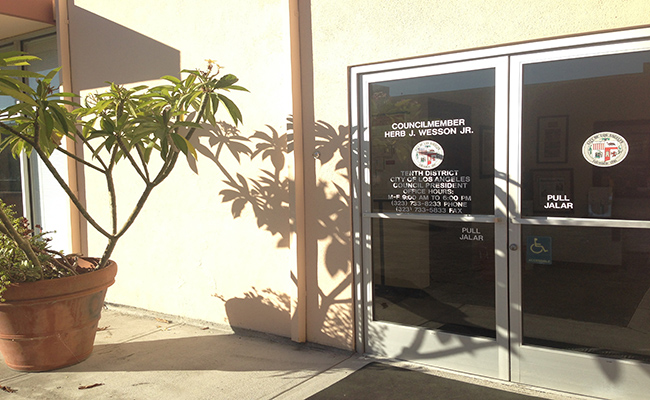The United Neighborhoods Neighborhood Council met recently to discuss matters in West Jefferson and Arlington Heights, but no one from these areas was present to vote on or discuss the issues. The disorganization and complex content of UNNC meetings may have deterred public participation despite its members’ good intentions.
A left turn at the run-down liquor store and a right at the corner where homeless men were sitting led visitors to the parking lot for the Council District 10 Field Office. A trip through glass doors then welcomed them to a room in shades of brown – tables, floors and walls. Harsh fluorescent lighting shone down upon the three small folding tables with peeling paint that converged to form a larger table. Large trashcans lined one wall and the only pop of color in the room was a fake plant leaning against one corner of the room. This was the location of the sparsely attended UNNC meeting, but there were no physical signs or notices that informed the public of the upcoming gathering.
Two people sat in this conference room at 6:30 p.m., the designated start time. Fifteen minutes later, Laura Meyers, the UNNC Planning Chair, ambled in wearing a loose-fitting cotton shirt and cargo pants. She urged two journalists to sit at the small table, encouraging them to “get closer to the action.” Curse words flew then from her mouth as she spoke with the others about how people owed her money, and she later said that she did “not know when [other members] [were] gonna show up” or if they would make it in time at all. Over the next ten minutes, three other people trickled into the room. At 6:59, the meeting scheduled for half an hour earlier began with six people present. Not one of these people, with the exception of journalists, was a non-committee member.
With an exasperated sigh, Meyers opened the meeting with the required approval of the agenda, asking if she “really [had] to do this every time.” Throughout the meeting — about building zones in Arlington Heights and West Jefferson – a phone rang twice, belonging to UNNC member Billie Green. She proceeded to answer the calls and spoke on the phone while sitting at the conference room table.
But what appeared to be a chaotic meeting flip-flopped when members began speaking in technical terms. A language of abbreviations and acronyms filled the air, lingo that would be cryptic to anyone unfamiliar with the complex details behind the building zones. Talk about restricting commercial building permits and new demolition laws passed through the room. According to Meyers, the building propositions were “more than what [she and the committee] had asked for” and she was “very happy.” The opinion was unanimous when voting was held on the state of these future building regulations in West Jefferson and Arlington Heights. (Although, still, no residents were present to contribute votes.)
The content may have been confusing to outsiders, but committee members were eager to share their story with a wider audience. One member, Norman Gilmore, checked the journalists’ records, asking, “did you get that?” to make sure they had written down certain ideas. Meyers, who was running the meeting, even paused in the middle of a sentence to spell out a word so that the journalists would not misquote her. At the meeting’s end, all six members were eager to give out their business cards.
Though attendance was “light” for this meeting, Meyers attributed the lack of public participation to its irregular scheduling; most other meetings occur each month at the same designated time and place as the last. Meyers said the committee would have otherwise reached its usual quota of about “eight to 10 well-informed stakeholders” had the meeting occurred during a regularly scheduled time. Thus, even on the UNNC’s most popular days, the fate of Los Angeles neighborhoods may still rest on the shoulders of just a handful of local committee members.
Like Intersections on Facebook, follow us on Twitter and sign up for the Newsletter to stay in the loop on news and views from South L.A.
















Great narrative! Good details. I think this is pretty common among neighborhood councils: sparse attendance, enthusiastic, but relatively livid NC board members; high use of lingo/jargon. All of that can be improved.
I would give them a bit of a break on this aspect: “(Although, still, no residents were present to contribute votes.)”
They deserve a break on this because, technically, residents don’t vote on such things (unless this was a committee meeting); though I think we should all recognize the importance of having community and resident input on all issues. There’s not doubt that is important.
Thanks for the great article!
Brett Shears, At-large Representative, Empowerment Congress North Area Neighborhood Development Council